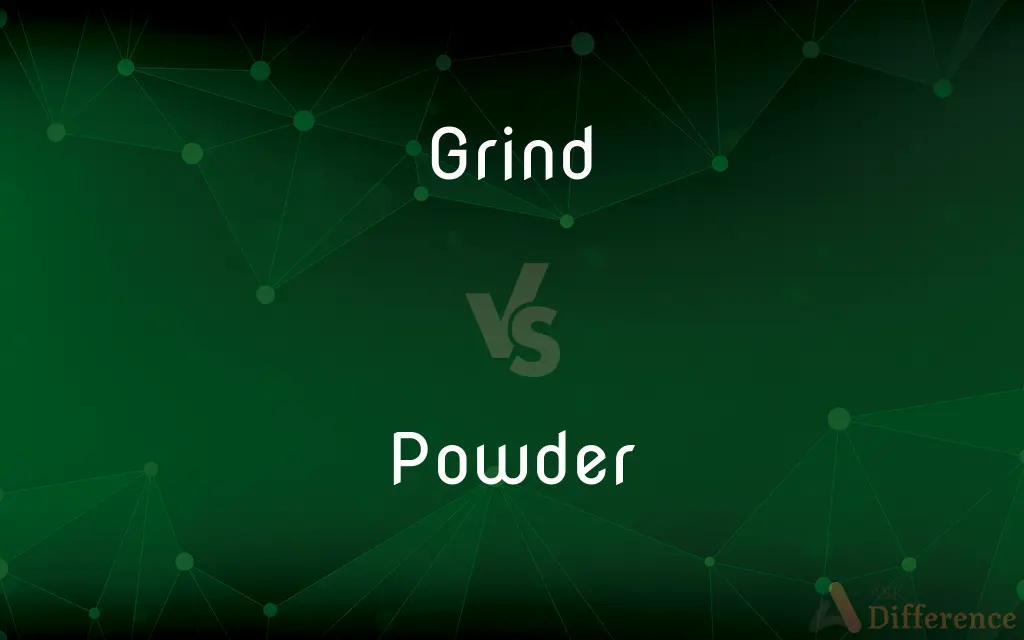Grind vs. Powder — What's the Difference?
By Tayyaba Rehman & Urooj Arif — Published on September 1, 2024
Grinding is the process of breaking down solid materials into smaller pieces or particles, used for coffee beans and grains. Powdering is the process of pulverizing solid materials into a fine, dust-like consistency, as seen with flour or powdered sugar.

Difference Between Grind and Powder
Table of Contents
ADVERTISEMENT
Key Differences
Grinding involves reducing the size of a material into smaller, often irregular pieces or particles, creating a texture that is coarser than a powder. This process is suitable for various applications, including preparing coffee beans for brewing, where the size of the grind affects the extraction rate and flavor profile. In contrast, powdering refers to the act of pulverizing materials into a very fine, uniform size, resulting in a powdery substance. This method is commonly used for making spices, flour, and powdered sugar, where a fine consistency is needed for even distribution in recipes or formulations.
The equipment used for grinding and powdering can vary. Grinders, which may be manual or electric, are typically used to achieve a coarser texture and can be adjusted to control the size of the grind. Powdering often requires mills or processors that are capable of producing very fine particles, sometimes with the help of sieving to ensure uniformity.
The choice between grinding and powdering depends on the intended use of the product. Grinded materials are often preferred when texture and particle size play a crucial role in the preparation and flavor of the food, such as with coffee or coarse spices. Powdered materials, on the other hand, are ideal for baking, cooking, and cosmetic applications, where a smooth, uniform consistency is desired.
Despite their differences, both grinding and powdering are essential processes in food preparation, manufacturing, and various other industries. Each method has its unique applications and benefits, from enhancing flavor and texture to ensuring consistency and functionality in products.
Comparison Chart
Texture
Coarser, irregular particles
Fine, dust-like consistency
ADVERTISEMENT
Process
Breaking down into smaller pieces
Pulverizing into a fine powder
Equipment
Grinders (manual or electric)
Mills, processors, with sieving for uniformity
Applications
Coffee beans, spices, grains
Flour, powdered sugar, spices
Intended Use
When texture and particle size are important
When a smooth, uniform consistency is needed
Compare with Definitions
Grind
Breaking down materials into smaller, coarser pieces.
Grinding coffee beans for a French press.
Powder
Pulverizing materials into a fine, dust-like consistency.
Powdering sugar to make powdered sugar.
Grind
Results in a coarser, variable particle size.
Coarse grind is used for slower brewing methods.
Powder
Achieves a very fine, uniform powder.
Powdered sugar is used for its ability to dissolve easily.
Grind
Utilizes grinders with adjustable settings.
Burr grinders allow for precise control over grind size.
Powder
Often requires mills or fine processors.
A food processor can be used to powder dried spices.
Grind
Ideal for coffee, spices, and grains.
Grinding whole spices before cooking to enhance flavor.
Powder
Used for making flour, powdered sugar, and fine spices.
Powdering cinnamon sticks for use in baking.
Grind
Preserves flavor and allows for texture variation.
Different grind sizes can affect the extraction and taste of coffee.
Powder
Ensures even distribution in recipes and formulations.
Powdered ingredients mix more uniformly in recipes.
Grind
To reduce to small bits or crush to a fine powder
Grind wheat into flour.
Grind coffee beans.
Powder
A substance consisting of ground, pulverized, or otherwise finely dispersed solid particles.
Grind
To shape, sharpen, or refine with friction
Grind scissors to a fine edge.
Grind lenses for eyeglasses.
Powder
Any of various preparations in the form of powder, as certain cosmetics and medicines.
Grind
To become crushed, pulverized, or powdered by friction
Those coffee beans ground easily.
Powder
The fine particles which are the result of reducing a dry substance by pounding, grinding, or triturating, or the result of decay; dust.
Grind
A specific grade or degree of pulverization, as of coffee beans
Drip grind.
Powder
(cosmetics) A mixture of fine dry, sweet-smelling particles applied to the face or other body parts, to reduce shine or to alleviate chaffing.
Grind
Something that has been reduced to powder, something that has been ground.
Powder
The fine particles to which any dry substance is reduced by pounding, grinding, or triturating, or into which it falls by decay; dust.
Grind their bones to powder small.
Grind
A grinding trick on a skateboard or snowboard.
Powder
To reduce to fine particles; to pound, grind, or rub into a powder; to comminute; to pulverize; to triturate.
Grind
To reduce to powder by friction, as in a mill, or with the teeth; to crush into small fragments; to produce as by the action of millstones.
Take the millstones, and grind meal.
Powder
A solid substance in the form of tiny loose particles; a solid that has been pulverized
Grind
To become ground or pulverized by friction; as, this corn grinds well.
Powder
Make into a powder by breaking up or cause to become dust;
Pulverize the grains
Grind
Reduce to small pieces or particles by pounding or abrading;
Grind the spices in a mortar
Mash the garlic
Common Curiosities
Can the same equipment be used for grinding and powdering?
Some equipment can serve both purposes, but powdering often requires additional processing to achieve a fine consistency.
Is powdered spice more potent than ground spice?
Powdered spices may offer a more immediate release of flavor, but both forms can be potent depending on the freshness and quality of the spice.
Why is uniformity important in powdered products?
Uniformity ensures consistent flavor, texture, and appearance in recipes and products, as well as proper integration of ingredients.
Why choose grinding over powdering for coffee?
Grinding coffee beans to a specific coarseness affects the brewing method and flavor extraction, offering control over the taste.
What's the difference between grinding and powdering?
Grinding produces coarser particles, while powdering results in a fine, dust-like consistency.
Can I make powdered sugar from granulated sugar at home?
Yes, by powdering granulated sugar in a food processor or blender, you can create powdered sugar.
Are there any drawbacks to powdering ingredients?
Over-powdering can sometimes lead to a loss of flavor or create clumping issues in humid environments.
How does particle size affect cooking or baking?
Particle size can affect the texture, distribution, and flavor release of ingredients in cooking and baking, with finer powders offering more uniformity.
How do I choose between a grinder and a mill for home use?
Consider the types of materials you plan to process and whether you need a range of textures or primarily fine powders.
Can grinding or powdering affect the nutritional value of food?
The nutritional value is generally preserved, but exposure to air and increased surface area can lead to quicker degradation of some vitamins.
Share Your Discovery

Previous Comparison
Computer Monitor vs. TV
Next Comparison
Gideon’s Bible vs. KJVAuthor Spotlight
Written by
Tayyaba RehmanTayyaba Rehman is a distinguished writer, currently serving as a primary contributor to askdifference.com. As a researcher in semantics and etymology, Tayyaba's passion for the complexity of languages and their distinctions has found a perfect home on the platform. Tayyaba delves into the intricacies of language, distinguishing between commonly confused words and phrases, thereby providing clarity for readers worldwide.
Co-written by
Urooj ArifUrooj is a skilled content writer at Ask Difference, known for her exceptional ability to simplify complex topics into engaging and informative content. With a passion for research and a flair for clear, concise writing, she consistently delivers articles that resonate with our diverse audience.












































